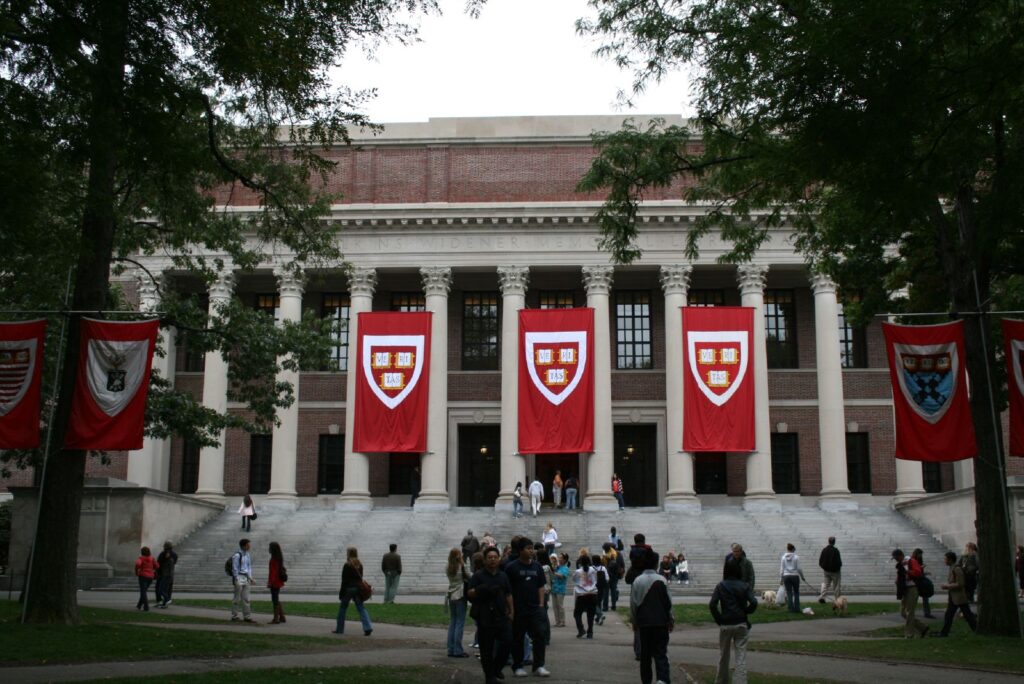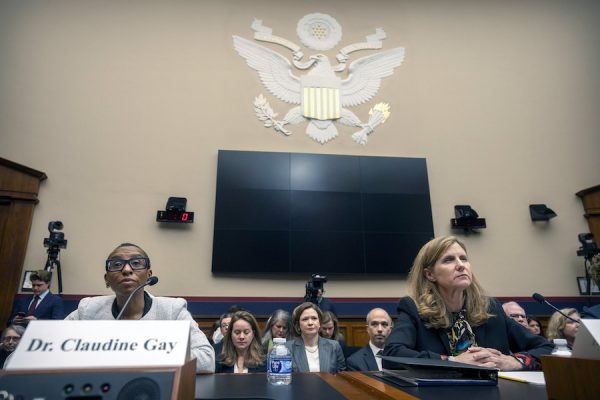Many Americans think of college—and especially the selective university—as a social leveler, offering upward mobility to anyone with talent and drive. This idea helps to justify the stark inequalities of twenty-first-century capitalism: anyone, we are told, can ascend an ever-steepening social and economic hierarchy and reap the growing rewards at the top. The elite status of the selective university seems available to all.
But, of course, it isn’t. The result is that class stratification, cutthroat capitalist competition, and racial resentment collide in university admissions. Consider just the last year’s worth of news.
Some say admissions ignores objective merit. But this view misunderstands the essentially classist character of the modern elite university.
First came the lawsuit claiming that Harvard discriminates against Asian American applicants, which was decided today in favor of Harvard. Strictly speaking, the suit made a specific claim of racial bias, but it was backed by a longtime foe of affirmative action and designed as a collateral attack on it. The case has fueled a more general critique of Harvard’s admissions process by revealing the extent to which wealth and social status influence decisions.
Then came the “Varsity Blues” conspiracy to game the admission process at schools such as Yale, Stanford, and the University of Southern California, involving fake credentials and hundreds of thousands of dollars in bribes. To many this scandal is simply the logical extension of long-accepted practice: it is well known that rich applicants boost their chances with test preparation, application coaching, resume-padding summer activities, and family donations. An explicit quid pro quo, the argument goes, is just a more straightforward version of the same transaction.
Some view these cases as symptoms of the same disease: a shadowy admissions process that ignores objective merit. But this view misunderstands the essentially classist character of the modern elite university, in which race figures only incidentally. Far from providing grist for another argument against affirmative action, the bribery scandal in fact shows why it is justified. It also suggests that broader attempts to democratize elite university admissions are unlikely to succeed.
The unstated assumption that folds affirmative action into a general critique of elite admissions is that acceptance should be based exclusively on individual merit (and that merit, in turn, should be measured by grades and test scores). Indeed, opponents of affirmative action often speak as if it is a departure from an otherwise even-handed and admirable meritocracy. But the Harvard case and the bribery scandal both expose—in high relief, if not for the first time—the extent to which non-racial (and hence legally unproblematic) admissions preferences dwarf those associated with race. Athletes, legacy applicants, and those otherwise likely to help universities secure large donations enjoy higher admission rates than members of underrepresented racial groups. Affirmative action is one of the more modest of many departures from numerical indicia of merit.
Critics also complain that elite admissions are secretive. But the real issue is not so much secrecy as indeterminacy: the process is fundamentally conflicted, relying on a hodgepodge of considerations and a mix of disparate criteria, rather than a single coherent idea of merit. This indeterminacy in turn piggybacks on the nature of the contemporary university itself, which is hardly a coherent institution with a single, well-defined mission. Instead it is an amorphous collection of distinctive, often unrelated, and occasionally mutually antagonistic enterprises. To have a clear sense of what a university should consider in admissions, one would need a clear sense of the mission of the university.
The real issue is not so much secrecy as indeterminacy: the process is fundamentally conflicted.
One of the university’s aims—if increasingly crowded out by others—is the discovery and dissemination of knowledge. If this alone were the goal, admissions might be based solely on academic promise, which grades and test scores reflect in a limited and imperfect way. But this is not the only mission. To many, universities today are “supposed to be the engines of social mobility and the gateways to dreams,” as New York Times columnist Frank Bruni colorfully puts it. This suggests universities should consider who would benefit most from admission. More prosaically, many universities manage several semiprofessional sports teams, for which they must recruit, necessitating a preference for athletes. And prestigious universities, in particular, have historically been finishing schools for the hereditary elite, a role that introduces criteria that favor the wealthy and powerful. This last role is distasteful to many, but it is hard to deny that it figures in elite admissions decision-making.
These roles can be complementary, but they are often in tension. The elite status that powers the “engine” of social mobility for the select few is in part a consequence of academic excellence. But it is also, in larger part, the result of networking with privileged young people who already enjoy the benefits of wealth and family connections. The effect of this preprofessional social networking—the chance to rub shoulders with and learn the habits, customs, and social mores of people whose success is guaranteed by their inheritance and their parentage—is powerful.
This elitism clashes with the idea of the university as a classless meritocracy, but it is indispensable to the status of the elite school and hence to the social mobility it offers. Consider a 2014 study that found that an elite college or university education has almost no effect on the later success of the typical well-heeled graduate: the children of privilege do no better after graduating from very prestigious universities than similarly situated peers who graduated from less elite schools. By contrast, a prestigious university degree does give a dramatic boost to black and Latino students and to students from lower-class backgrounds.
The discrepancy is somewhat puzzling if the social mobility offered by an elite school education is a consequence of the education itself: one might expect a better education at an elite school to provide a greater boost to all students. But it makes perfect sense if the benefits lie largely in networking, socialization, and elite credentialing. The university has little to offer the upper-class student in terms of networking opportunities, acculturation to upper-class norms, and the imprimatur of the elite; she has these already by virtue of her social class. It is the lower-class student who stands to gain them by attending an elite university or college. This is not to suggest, as some have, that higher education is “worthless,” even to people who are already privileged. It also does not prove that the education offered in elite schools is no better than in less elite schools. But it does suggest that whatever its superiority, it does not lie in instrumental career advantage. The competitive edge comes from networking, socialization, and the halo that surrounds an elite school credential.
As a practical matter, then, so-called merit-based admissions—however one defines merit—can only go so far: the children of the elite must always predominate if the school is to remain elite. A truly elite school admits the most talented student body it can while still ensuring that most of the student body is drawn from the upper class. If it were not for the American myth of the classless society, we could admit that an elite education is, among other things, a class credential. Elite admissions could then be understood as a ritual through which the upper classes sort themselves and decide which lucky members of the lower orders to admit into their ranks.
If it were not for the myth of the classless society, elite admissions could be understood as a ritual through which the upper classes sort themelves.
I should add that social class is not synonymous with income. Class refers to a culture and sensibility as much as it does to money. The families in the “Varsity Blues” scandal were all rich, but few were upper class: instead they were B-list actors and nouveaux riches professionals and financiers. For them, an elite school did not necessarily offer the prospect of increased wealth—indeed, most probably paid more for bribes than the education was worth in increased future earning potential. Instead it offered upward class mobility: buying a child’s way into Yale is today’s equivalent of a nineteenth-century industrial tycoon buying an aristocratic title.
The imperative to preserve elite status by maintaining an affiliation with the upper class is never stated openly. Instead, it most likely plays an unconscious role in informing whether an applicant will be a “good fit” or further the “values of the institution,” and whether an entering class is a “good” one. All of this can be done without explicit reference to social class, because the idea of class is baked into the very culture of elite institutions: it is what gives them their character and makes them elite.
This fact explains all the preferences in elite admissions so many consider problematic: legacies; athletes who play expensive, patrician sports such as lacrosse, sailing, and crew; and, to some extent, the generic focus on well-roundedness, good citizenship, and personality, all of which have an unavoidable cultural and class definition. It is also reflected in the preference for applicants whose admission might inspire large donations to the school: here there is the direct benefit of helping to secure the donation, as well as the indirect but equally important benefit that such an applicant is almost certainly from an upper-class family. And last, this imperative to admit the upper class is reflected, of course, in elite schools’ focus on high school grades and standardized test scores. Standardized tests predict nothing better than family income: the tests measure skills and knowledge reinforced in upper-class homes and private school. (When I took the SAT in the 1980s, one of the verbal questions was “scull is to river as car is to (a) garage, (b) brakes, (c) driver, (d) asphalt.” The correct answer, I believe, is d.) Moreover, reassuringly expensive academic test coaching promises to boost an applicant’s score by up to 200 points, depending on how much coaching one “invests” in.
The imperative to preserve elite status introduces an indirect and inadvertent kind of racial disadvantage for non-white applicants.
Grades and test scores get extra weight because of their importance in rankings, especially the U.S. News and World Report’s. High rank offers bragging rights and reinforces elite status. It is also self-perpetuating: because most applicants don’t have the information or ability to distinguish between universities and colleges based on educational quality, many select based on rank. Of the many factors that contribute to a school’s rank, the easiest for the school to control is the average standardized test score of its student body, so selective schools compete for students with the highest numbers. This provides an additional incentive for the universities to use test scores in their admissions decisions and to give small differences in scores more weight than their predictive value warrants. (The College Board itself admits that SAT score differences of up to 40 points should not be considered significant.) As a consequence, academic merit is taken to be synonymous with standardized test scores and grades.
Race plays a minor, incidental role in all of this. Until very recently, the upper class in the United States had been racially exclusive by design, and it remains overwhelmingly white. The imperative to preserve elite status by dint of affiliation with the upper classes introduces an indirect and inadvertent kind of racial disadvantage for non-white applicants.
This preference is indirect because it does not refer to race explicitly, and even most white applicants do not benefit. And it is inadvertent because the admissions officer is not deliberately trying to increase the number of white people admitted; she is trying, perhaps unselfconsciously, to increase the number of upper-class students admitted. From this point of view, affirmative action simply corrects for the unavoidable racial impact of a set of admissions policies that benefit the upper-class applicant. In this respect, the bribery scandal shows precisely why affirmative action is necessary.
The claim that Harvard discriminates against Asian American applicants is best understood in this light. If grades and tests scores were the only consideration, the number of Asian Americans admitted to Harvard would be much higher. But the data revealed during the Harvard litigation is consistent with discrimination based not on race, but on signs of social class. Because social classes come with distinctive cultures, signals of a particular class status may be considered virtues by many members of that class. Qualities such as well-roundedness, likability, intellectual curiosity, and leadership skills are unavoidably culturally specific. Thus, even if elite admissions officers are innocently evaluating applicants based on what they consider to be qualitative merits, they may be unselfconsciously selecting applicants who had best assimilated to upper-class cultural norms. And because Asian American applicants as a group do especially well on standardized tests regardless of social class, high test scores are more likely to align with elite social class for white applicants and less likely to do so for Asian American applicants. Class-based criteria were thus especially disadvantageous to those Asian American applicants who seemed highly qualified based on their grades and test scores alone. But such indirect class-based discrimination is not unlawful, and it is hard to see how it could be distinguished from legitimate qualitative evaluation as a practical matter.
What is most depressing about the latest conversation about university admissions is that it ignores all that is best about the university: its primary and most important function as a place of learning, insulated if not divorced from the profit motive. In our capitalist society that is driven by the bottom line, this is a type of privilege to be sure—not because it promises competitive advantage in a cutthroat job market or access to exclusive networking opportunities, but because it offers the luxury of intellectual freedom. This freedom contributes to new innovations and improvements in practical endeavors, of course, but these are often diffuse social benefits rather than individualized competitive advantages. Sadly, the exclusive focus on social mobility in the form of career advantage has all but eclipsed any discussion of these virtues.
The most sympathetic critics of affirmative action are really critics of the university admissions process more generally.
The Harvard ruling and the bribery scandal will lead to calls for reform of the admissions process, and there is plenty to criticize. But much of the uproar has been based on unrealistic and even incoherent ideas about the nature of selective universities, their strengths, and what they can accomplish. The myth of the classless society allows the critics of university admissions to pretend that selective universities could somehow be less elitist but still just as elite. And this has meant that all the resentment over the classist aspects of university admissions has been displaced onto the relatively minor issue of race-based affirmative action.
The most sympathetic critics of affirmative action are really critics of the university admissions process more generally, but because almost all of what is most troubling about university admissions is perfectly lawful, the legal vulnerability of race-based affirmative action provides the only foothold from which to leverage attacks on the whole process. The strategy is confused and occasionally dishonest, but it is motivated by legitimate grievances. There is also a far less defensible impulse underlying attacks on affirmative action, driven not by concern for the white and Asian American applicants who are rejected but by resentment of the black and Latino applicants who are admitted. Class dynamics also explain this: hostility to affirmative action is often an instance of a characteristic U.S. antipathy toward uppity dark-skinned people who attempt to rise above their condition. What galls many critics of affirmative action is that it allows a smattering of black and Latino people to acquire an elite credential—complicating, if not exactly challenging, familiar racial hierarchies.
The discontent with elite university admissions reflects deep status anxieties and resentments, which, because they are suppressed and cannot be openly discussed, are unlikely to be resolved. It also reflects concerns over income polarization and diminished opportunities of success that public policy can and should address.
But fighting to revise selective university admissions policy is not the most promising way to address them. Greater investment in public universities, typically much larger and less dependent on elite legacy, might be more effective at promoting social mobility. Investment in economic development and job creation certainly would be. And to the extent that resentment of elite universities reflects legitimate resentment of elites generally, a more direct approach—such as taxation reform designed to reverse the polarization of income—would be far more constructive. The admissions scandals are a symptom of a society that pretends that elitism could be democratized—in which what passes for egalitarian struggle amounts to desperate individual attempts to ascend a steepening social hierarchy rather than a collective effort to level it. The demand for an equal opportunity to elite status is almost a contradiction in terms. A better egalitarian goal would be to level the social hierarchy that increasingly reserves a comfortable life to an elite few.








